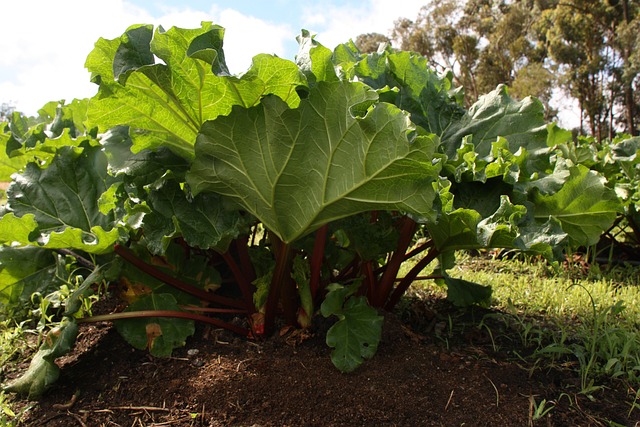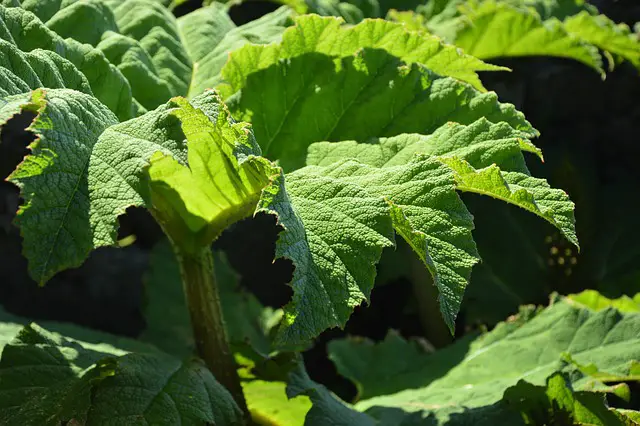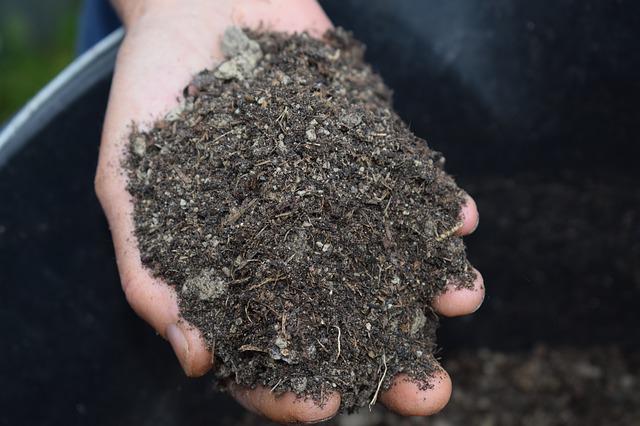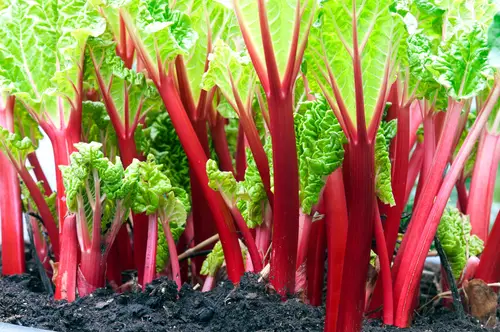Rhubarb is a popular garden plant that is known for its tart and tangy flavor. However, gardeners may notice that their rhubarb leaves are turning yellow, which can be a cause for concern. Understanding why rhubarb leaves turn yellow can help gardeners identify and address any issues that may be affecting their plants.
Yellowing leaves are a common sign of stress in rhubarb plants. While some yellowing may be normal, excessive yellowing can be a sign of a problem.
Common causes of Rhubarb Leaves Turning Yellow include nutrient deficiencies, fungal attacks, pest problems, and environmental stressors such as overwatering or exposure to heat. By identifying the cause of yellowing leaves, gardeners can take steps to prevent further damage and help their rhubarb plants thrive.
Key Takeaways
- Yellowing leaves are a common sign of stress in rhubarb plants.
- Common causes of yellowing leaves include nutrient deficiencies, fungal attacks, pest problems, and environmental stressors.
- By identifying the cause of yellowing leaves, gardeners can take steps to prevent further damage and help their rhubarb plants thrive.
More posts on this category:
- Why Are My Prayer Plant Leaves Turning Yellow?
- Why Are My Soybeans Turning Yellow?
- Why Are My Pilea Leaves Turning Yellow?
Understanding Rhubarb Plants

Rhubarb is a vegetable that belongs to the buckwheat family. It is a hardy plant that can tolerate cold temperatures and is known for its tart flavor. Rhubarb plants are easy to grow and can produce for many years if cared for properly.
Rhubarb plants have large, broad leaves that are green in color. These leaves are an important part of the plant’s photosynthesis process, which allows it to produce energy from sunlight. The stalks of the rhubarb plant are the part that is typically eaten, and they are usually red or pink in color.
One important thing to note about rhubarb plants is that they are toxic if consumed in large quantities. The leaves of the plant contain high levels of oxalic acid, which can be harmful if ingested. For this reason, it is important to only eat the stalks of the plant and to discard the leaves.
Rhubarb plants require a lot of water to grow properly. They prefer to be planted in soil that is rich in nutrients and well-draining. It is also important to ensure that the plant gets enough sunlight, as this is necessary for photosynthesis to occur.
In addition to proper watering and sunlight, it is important to keep an eye out for pests and diseases that can affect rhubarb plants. Common pests that can affect rhubarb include aphids, spider mites, slugs, and snails. Diseases that can affect rhubarb plants include crown rot, root rot, and powdery mildew.
Signs of Yellowing Leaves
Yellowing leaves on a rhubarb plant can be an indication of several underlying problems. Here are some signs to look out for:
- Yellowing leaves: Rhubarb leaves that are yellowing from the edges or tips are a sign of a nutrient deficiency or pest infestation. In some cases, the entire leaf may turn yellow and wilt.
- Spots or blotches: If the leaves have yellow spots or blotches, it may be a sign of a fungal infection.
- Brown or black patches: Brown or black patches on the leaves can be a sign of sunscald or sunburn, which occurs when the leaves are exposed to too much direct sunlight.
- Curling or wilting: Curling or wilting leaves can be a sign of water stress, either too much or too little water.
- Holes or chewed edges: Holes or chewed edges on the leaves can be a sign of pest infestation, such as aphids or slugs.
Rhubarb Leaves Turning Yellow – 5 Common Problems

Yellowing leaves on rhubarb plants can be a sign of various issues, ranging from nutrient deficiencies to pests and diseases. It is essential to identify the underlying cause of the problem to take appropriate measures and save the plant. Here are some of the common causes of yellowing leaves in rhubarb plants:
1. Nutrient Deficiencies
Rhubarb plants require a balanced amount of nutrients to grow and thrive. A lack of essential nutrients like nitrogen, iron, or potassium can cause yellowing leaves.
Over-fertilization can also lead to nutrient imbalances, causing yellowing or reddening of leaves. It is crucial to provide the plant with the right amount of nutrients at the right time to avoid such issues.
2. Watering Issues
Overwatering or underwatering can cause yellowing leaves in rhubarb plants. Overwatering can lead to root rot, causing yellowing and wilting of leaves.
On the other hand, underwatering can cause dehydration and nutrient deficiencies, leading to yellowing, curling, or browning of leaves. It is crucial to water the plant correctly, keeping the soil moist but not waterlogged.
3. Pest Infestations
Pests like aphids, spider mites, slugs, and snails can feed on the leaves, causing yellowing and even wilting. Additionally, pests can transmit diseases that can further damage the plant. It is essential to identify and control pest infestations promptly.
4. Diseases
Fungal diseases like ascochyta leaf spot, ramularia leaf spot, rust, and crown rot can cause yellowing of leaves in rhubarb plants. Bacterial infections can also lead to yellowing, wilting, and stunted growth. It is crucial to identify and treat the disease promptly to prevent further damage.
5. Temperature and Sunlight
Rhubarb plants prefer cooler temperatures and partial shade. Exposure to heat and direct sunlight can cause yellowing and browning of leaves. It is crucial to provide the plant with adequate shade and airflow to avoid such issues.
Prevention and Treatment

Preventing yellowing of rhubarb leaves is essential to ensure a healthy and productive plant. There are several measures that can be taken to prevent and treat the yellowing of rhubarb leaves, including:
1. Soil Test and Fertilizing
Rhubarb plants require a well-draining soil with a pH between 6.0 and 6.8. A soil test can help determine the soil’s nutrient content and pH level. If the soil lacks nutrients, a balanced fertilizer with equal parts of nitrogen, phosphorus, and potassium can be added to the soil.
2. Watering
Rhubarb plants require regular watering to keep the soil moist. Overwatering or underwatering can cause yellowing of the leaves. A moisture meter can help determine the soil’s moisture level, and watering should be adjusted accordingly.
3. Airflow and Screen
Good airflow is essential to prevent fungal infections and pest infestations. A screen can be used to protect the plant from slugs and other pests while allowing for proper airflow.
4. Organic Matter and Manure
Adding organic matter such as compost or manure to the soil can improve soil structure and nutrient content. However, too much organic matter can cause nitrogen deficiency and yellowing of the leaves.
5. Baking Soda and Diatomaceous Earth
Baking soda and diatomaceous earth can be used to treat fungal infections and pests. Baking soda can be mixed with water and sprayed on the plant, while diatomaceous earth can be sprinkled around the plant to deter pests.
6. Neem Oil and Insecticide
Neem oil and insecticides can be used to treat pest infestations. Neem oil can be mixed with water and sprayed on the plant, while insecticides should be used according to the manufacturer’s instructions.
7. Crown Rot and Leaf Spot
Crown rot and leaf spot are fungal infections that can cause yellowing of the leaves. Fungicides can be used to treat these infections, and infected plant parts should be removed and disposed of.
8. Blood Meal and Phosphorus
Blood meal and phosphorus can be added to the soil to provide additional nutrients. Blood meal is a good source of nitrogen, while phosphorus is essential for root development.
Rhubarb in Different Seasons

Rhubarb is a hardy perennial plant that can grow in different seasons. However, the plant’s growth and the quality of the crop depend on the season and the temperature. Here are some things to keep in mind when growing rhubarb in different seasons:
Summer
During summer, rhubarb plants can continue to grow, but the heat can cause the leaves to wilt and turn yellow. The plant needs to be watered regularly and kept in a shaded area to prevent heat stress.
If the leaves start to turn yellow, it could be a sign of overwatering or underwatering. It’s essential to keep the soil moist but not waterlogged.
Winter
Rhubarb plants go dormant during the winter season. The leaves will start to die back, and the plant will store its energy in the roots. It’s essential to protect the plant from frost and freezing temperatures by covering it with mulch or straw. The plant will start to grow again in the spring season.
Heat Exposure
Rhubarb plants prefer cooler temperatures and can suffer from heat stress. If the plant is exposed to high temperatures for an extended period, the leaves can turn yellow and wilt. It’s essential to provide the plant with partial shade during the hottest part of the day.
Nutritional Aspects of Rhubarb
Rhubarb is a nutrient-dense vegetable that is low in calories and high in fiber. It is a good source of vitamins, minerals, and antioxidants that can provide several health benefits.
Here are some of the nutritional aspects of rhubarb that you should know about:
Nutrients
Rhubarb is a good source of several essential nutrients, including vitamin K, vitamin C, calcium, and potassium. It also contains smaller amounts of other vitamins and minerals, such as vitamin A, vitamin E, folate, and magnesium.
Nutrient Deficiencies
Nutrient deficiencies can cause rhubarb leaves to turn yellow or red. A lack of nitrogen, iron, magnesium, or sulfur can all contribute to yellowing leaves.
Nitrogen is an essential nutrient for plant growth and is required to produce chlorophyll, which gives leaves their green color. Iron is also important for chlorophyll production, while magnesium is necessary for photosynthesis.
Manure and Compost

One way to provide nutrients to rhubarb plants is by using manure or compost. Manure is a good source of nitrogen, phosphorus, and potassium, while compost is rich in organic matter and can help improve soil structure and fertility.
However, it is important to use these materials carefully, as too much can lead to nutrient imbalances or even toxicity.
Nitrogen, Phosphorus, and Potassium
Nitrogen, phosphorus, and potassium are the three primary macronutrients that plants need to grow. Nitrogen is important for leafy growth, while phosphorus is needed for root development and flowering. Potassium is necessary for overall plant health and helps plants resist disease and stress.
Taste Profiles of Rhubarb
Rhubarb is a unique vegetable that has a distinct taste profile. It is known for its tangy, sour, and slightly bitter flavor. The taste of rhubarb is often described as a combination of apple, strawberry, and lemon. The flavor of rhubarb varies depending on the cultivar, the age of the plant, and the way it is prepared.
Rhubarb stalks are the edible part of the plant, and they have a crisp texture with a fibrous interior. The stalks are usually cooked before consumption, and the cooking process can affect the flavor and texture of the rhubarb.
When rhubarb is cooked, it becomes less tangy and sour, and the sweetness of the vegetable becomes more apparent. The sweetness of rhubarb is due to the presence of natural sugars, such as fructose and glucose. However, the sweetness of rhubarb is not overpowering, and it is balanced by the tartness of the vegetable.
Rhubarb is a versatile vegetable that can be used in a variety of dishes. It is commonly used in pies, jams, and sauces. Rhubarb can also be used in savory dishes, such as stews and curries, to add a tangy flavor to the dish.
Frequently Asked Questions
What causes yellowing of rhubarb leaves?
Yellowing of rhubarb leaves can be caused by a variety of factors, including nutrient deficiencies, imbalanced watering, pests, diseases, and extreme temperatures.
Nitrogen, iron, magnesium, or sulfur deficiencies can cause yellowing leaves. Improper watering, either too much or too little, can also cause yellowing. Pests like aphids and diseases like crown rot can also cause yellowing of the leaves.
How do I prevent rhubarb leaves from turning yellow?
To prevent rhubarb leaves from turning yellow, it is important to provide them with proper care. This includes ensuring they have enough water, but not too much, and providing them with the necessary nutrients.
Regular fertilization with a balanced fertilizer can help prevent nutrient deficiencies, while proper watering techniques can prevent over or under watering. It is also important to keep an eye out for pests and diseases and address them promptly.
What are the signs of overwatered rhubarb?
Overwatered rhubarb can show signs of yellowing leaves, wilting, and root rot. The leaves may also appear soft and mushy. In severe cases, the plant may die.
Why do rhubarb leaves curl up?
Rhubarb leaves may curl up due to a lack of water or high temperatures. Curling leaves can also be a sign of pests or diseases, such as spider mites or powdery mildew.
What are the common reasons for rhubarb leaves turning brown?
Rhubarb leaves may turn brown due to fungal diseases such as leaf spot or crown rot. Brown leaves can also be a sign of overwatering or underwatering, or exposure to extreme temperatures.
How can I save my dying rhubarb plant?
If your rhubarb plant is dying, it is important to identify the cause of the problem. If it is due to a lack of water, provide it with more water. If it is due to pests or diseases, address the issue promptly. If the plant is severely damaged, it may not be possible to save it. In this case, it may be best to remove the plant and start fresh.

Hey, I’m Lisa and I’ve been an avid gardener for over 30 years. I love writing, talking and living in the garden! Feel free to connect with me on my socials below


